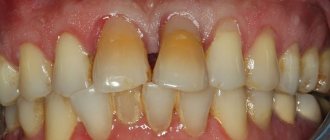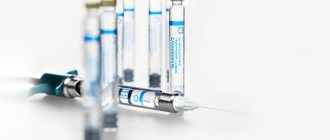After tooth extraction, the state of the dental system changes, the chewing load is redistributed, the bone tissue in the resulting gap is stabilized, and the hole is overgrown. All changes occur gradually, but over time the consequences manifest themselves in the form of bone atrophy, changes in the bite and subsidence of the gums. Is it possible to place an implant immediately after removal? Only an experienced specialist will answer the question, since it directly depends on the patient’s health condition. What implantation methods do modern dentistry offer and when can a dental implant be installed? Let's take a closer look.
Implantation methods after tooth extraction
Dental implantation after extraction is carried out according to two protocols:
- One-stage - involves installing an implant immediately into the socket of the extracted tooth. There are techniques that allow not only the installation of an implant, but also the fixation of a crown on it.
- Delayed - requires complete healing of the hole and restoration of bone tissue after removal. The bone is restored in 2-5 months depending on the health of the patient. Only then is implantation carried out.
When to insert an implant immediately after extraction
- If there is inflammation;
- fistula, granuloma, cyst;
- against the background of diseases of the mucous membrane;
- with insufficient bone volume or pathological changes;
- if the removal was performed carelessly (severely injured hole) and more.
Contraindications also include systemic diseases :
- diabetes;
- pathologies of the endocrine system;
- oncology;
- mental disorders, depression;
- allergy to anesthetics;
- weakened immunity due to viral and bacterial infections;
- tuberculosis;
- HIV, syphilis;
- hemophilia and other blood diseases;
- chronic diseases at the acute stage, etc.
Sometimes situations arise when one-stage implantation is not completed. In this case, the operation is completed after extraction. The implant installation procedure is postponed for some time to allow the wound to heal. Next, treatment is performed according to the classical protocol.
When it is possible to perform implantation - the doctor chooses after a complete diagnosis
It is necessary to study the condition of the bone tissue, its size and density. Based on the results, the doctor makes a decision - delayed or immediate implantation. Our Center is equipped with diagnostic equipment, so results can be obtained within 15 minutes . But this is only a preliminary assessment; the final decision is made after tooth extraction.
Levin Dmitry Valerievich
Chief physician, Ph.D.
Indications and contraindications for immediate implant placement
Indications
- Mechanical damage to the root - fracture, dislocation
- Restoration of frontal units
- Therapeutic treatment did not bring results
- Sufficient bone volume
- No contraindications
Contraindications
- Deficiency, looseness of bone
- Inflammation at the root apex
- Enlarged socket after removal
- Inflammatory processes of the oral cavity, gum pathologies
- Reduced immunity, systemic diseases
- Pregnancy, breastfeeding period
Types of dental crowns for chewing teeth
When choosing a material for creating a microprosthesis, you should take into account the functional purpose of the teeth. The molars of the posterior zone of the dentofacial apparatus are subjected to strong mechanical and chemical stress when chewing food.
Eating food that differs in taste, composition and hardness can quickly damage the nozzle, which is made of aesthetic material, but vulnerable to the abrasive properties of some products. In addition, the material should not cause allergies to the soft tissues of the oral cavity.
Therefore, it is better to entrust the choice of material for making crowns to a specialist.
How to do dental implantation immediately after extraction
After a tooth is removed and an implant is immediately placed, the process of osseointegration occurs faster. The hole with the artificial root begins to heal, the blood clot turns into bone tissue that surrounds the implant in the early stages of healing. This promotes accelerated osseointegration of the implant with the jawbone, ensuring reliable fixation and stability.
Stages:
Diagnostics
Full diagnostics, choice of design in the absence of contraindications.
Tooth extraction, artificial root installation
Local anesthesia or sedation is used. A bed is formed in the hole, an implant is installed, and the space around is filled with osteoplastic material. After the procedure is completed, the gums are sutured. A temporary removable prosthesis is installed. Engraftment lasts 4-6 months.
Prosthetics
After osseointegration of the implant with the jaw bone, the gum is opened, and a gum former is fixed to the implant for 10-14 days to create a gum contour. Then the former is replaced with an abutment, and a crown made from the impression is installed.
In rare cases, it is possible to fix the crown to the implant immediately after its installation. At the same time, the crown is removed from the bite so that the implant does not move during chewing. This method is recommended for the anterior parts of the jaw in order to quickly restore the defect. Not suitable for lateral use due to active chewing loads.
Do I need to insert a tooth myself?
In case of incomplete dislocation, the crown that protrudes strongly from the gums at the scene of the incident can be carefully inserted into place without applying significant effort. This will prevent complete tooth loss, the likelihood of which is quite high. But you shouldn’t touch a knocked-out baby tooth; it’s better to quickly go to the dentist to identify possible damage to soft tissue and bone.
If a piece of a tooth breaks off, you should rinse your mouth with clean water, try to find the fragment and rush to see a qualified doctor.
Advantages and disadvantages of one-stage dental implantation
pros
- One operation is performed, waiting time is reduced
- Simplified installation process
- Minimal loss of mucous and bone tissue after surgery
- If the technology is followed, the percentage of successful operations is 99.6%
Minuses
- Contraindicated in chronic inflammation, diseases
- Not performed if there is insufficient bone
- Strict rehabilitation period, frequent visits to the implantologist
For a favorable outcome, entrust the operation to a surgeon with extensive experience in this protocol.
Is it possible to place an implant if a tooth has been lost for a long time?
Whether it is possible to place an implant if the tooth was removed a long time ago is decided only by the surgeon after a complete diagnosis. Already 3 months after removal, the bone is so absorbed that it may not be enough to install an implant and augmentation will be required. The recommended implantation period is no later than 2-3 months.
In case of bone atrophy, osteoplasty is performed:
- Guided bone regeneration . Most often performed on the lower jaw, bone materials, biomembranes, and bone growth stimulators are used. It is used if the width and height of the patient’s bone is not enough for implantation. If bone tissue atrophy is insignificant, it is possible to perform NCR simultaneously with the installation of implants. Otherwise, it is carried out in a separate preliminary stage. It takes 3-4 months for the grafted material to fuse with the bone.
- Sinus lift. Intervention in the bone structure of the upper jaw in the area of the maxillary sinuses. Using instruments, tissue is punctured to raise the bottom of the sinus. The resulting space is filled with osteoplastic material. The operation can be closed or open. A closed sinus lift is performed for minor bone atrophy simultaneously with the installation of implants. Open - for moderate and critical atrophy in a separate stage.
Re-prosthetics for severely damaged teeth
Every dentist in his practice very often encounters the task of repeated dental prosthetics. And as a rule, after removing old structures, a thin stump of a tooth that has been aggressively treated for a crown is discovered. This is due to outdated principles of prosthetics, when there was no talk of adhesive fixation.
Repeated prosthetics are caused by a number of problems awaiting the doctor, such as: root caries and violation of biological width, lack of ferrule effect, as well as complete destruction of the stump.
The question arises, how can one predict recovery and accurately outline a treatment plan for the patient before removing the old structure?
The answer is simple - this cannot be done for sure! Therefore, in my practice I apply the principle of “diagnostic autopsy”. Patients with such a clinical situation, after being informed of possible treatment options, are offered a diagnostic visit, after which a final decision will be made whether to preserve or remove the tooth.
What does a “diagnostic autopsy” consist of: old structures are removed, the condition of hard tissues, effect ferrules and periodontal tissues is assessed, as well as the possibility of their restoration. Temporary structures are made for the patient using the key made before the old structures were removed and further actions are discussed.
Let's look at the stages of treatment using a clinical example.
Photo 1. Metal-ceramic crowns connected together were previously installed on teeth 1.1, 2.1. Probing revealed overhanging edges of the crowns, as well as a deep subgingival location of the crown border on tooth 1.1.
Photo 2. Before removing the crowns, a silicone key was made.
Photo 3. After removing the old structures, the condition of the root and stump of the teeth was assessed. A violation of the biological width is also visible.
Photo 4. The remains of the composite and areas of carious lesions were removed with a bur. An ultrasonic nozzle was used to clean the cervical area of the teeth. CBCT shows normal endodontic status. Therefore, retreatment of the canals would be required only in the case of depressurization on the endoaccess side. An attempt to extract such a volume of pins is fraught with excessive thinning of the root and, as a consequence, the impossibility of preserving the teeth.
Photo 5. To restore the biological width, as well as enhance the ferrule effect, surgical lengthening of the crown part of the teeth was performed. Gingivoplasty in area 2.1 and gingivosteoplasty in area 1.1. After suturing, temporary restorations were made using a silicone key for 2 weeks.
Photos 6, 7. After 2 weeks, the stumps were restored with Core composite after sandblasting with aluminum oxide. Impressions were taken for laboratory temporary restorations.
Photo 8. Condition of soft tissues at the time of fixation of temporary single structures made of CAD/CAM composite.
Photos 9, 10. Condition of soft tissues after 1 year of wearing temporary structures.
Photo 11. The CAD/CAM system allows you to repeat the formed perigingival contour of temporary restorations in permanent structures, which is undoubtedly a big advantage and ease of use.
Photo 12. Immediately after fixation of ceramic crowns made of solid milled press ceramics, tooth 1.2 was temporarily restored with packable composite in a layer-by-layer technique, for financial reasons of the patient.
Subsequently, it is possible to make an exact copy of a ceramic veneer for tooth 1.2 by comparing digital scans before and after preparation.
Photos 13, 14. Follow-up examination after 1 week. The structural, functional and aesthetic parameters of the teeth are restored, and a healthy gum condition is achieved.
Price
The Center for Private Dentistry Dr. Levin provides a case payment system.
- When implanting Nobel Biocare PMC Select or Groovy, the cost includes the surgical stages, including the design model, surgery, anesthesia, and all necessary procedures. The price is indicated taking into account the preparatory stage.
- Removal is paid separately, the price includes surgery, inflammation relief, socket rehabilitation, consumables, anesthesia.
- The case for installing a metal-free zirconium dioxide crown includes all stages - impressions, manufacturing, installation.
- Sinus lifting and any bone tissue augmentation operations are paid separately.
Alternative options for tooth restoration after extraction
After removal, doctors recommend restoring the tooth in a short time. This is caused by bone tissue atrophy, which begins in the absence of chewing load, which complicates recovery in the future.
If for some reason the patient is not ready for implantation, alternatives can be offered:
- Bridge prosthesis. It is a non-removable structure of interconnected crowns. For installation, two supporting teeth are depulped (nerve removal, canal filling) and ground down for crowns. At the same time, the load on the support increases, mobility develops, which is why the bridge will need to be replaced. The bridge structure is not able to completely prevent bone tissue atrophy, but it prevents rarefaction, displacement, and curvature of the dentition. The rate of bone atrophy and the development of mobility depend on the patient’s health.
- Removable dentures . They represent a structure made of artificial gum with soldered crowns, attached to adjacent teeth with hooks. The supporting teeth are ground down if the fastenings are metal. The prosthesis has a range of mobility and requires careful care, since food particles can get under it. Removable dentures do not stop atrophy, but they do prevent displacement of adjacent units.
Implantation prevents all problems, including bone atrophy. An implant is an artificial root on which a crown is placed. Neighboring teeth are not ground down or damaged. The chewing load is maintained. The survival rate of dental implants is 98%. Implantation is considered the most reliable way to prevent bone resorption.
Where to go for molar implantation in Moscow
Dental implants eliminate discomfort, stimulate bone tissue and gums, and provide a stable base for artificial teeth. Implantation of molars provides comfort to patients and normal performance of chewing functions. Implants are biocompatible, guarantee long-term prosthetic reconstruction, preserve healthy teeth and are an excellent means of preventing bone loss.
- The absence of one chewing tooth is one of the indications for implantation. The advantage is that the adjacent teeth remain intact. In traditional bridge making, the teeth have to be prepared. While implantation of molars does not require intervention in neighboring units, the crown on the implant completely replaces the lost tooth in terms of functionality.
- If several natural teeth are lost, implants can be used to form the basis of a bridge. Healthy teeth remain intact, and the prosthesis is firmly fixed to the implants. There is no need for inconvenient clasps and other supports for orthopedic structures. A bridge prosthesis on implants 100% restores impaired chewing functions.
Contact specialists in the implantation of chewing teeth in Moscow if you have single or multiple defects. Approximate prices for such services are shown in the table below. Remember, the choice of dentistry and doctor is the key to a successful result!
| Name | Clinic address | Service cost |
| ROOTT |
|
|
| Shandora | Moscow, Kolpachny lane, 6, building 4. |
|
| Dentistry Grand Smile | Moscow, st. Miklouho-Maklaya 43 (metro station Belyaevo, Yugo-Zapadnaya, Kaluzhskaya) | Prices for dental implantation from 30,000 rubles (MIS system) to 70,000 rubles (Nobel) |
| Dentistry City Dent | Moscow, st. Novocheremushkinskaya, 57 | Implantation of one tooth with the Astra Tech system – 52,000 rubles |
| Dentistry Vita-Stom |
| Implantation of one tooth with the Straumann system (Switzerland) – from 32,000 rubles. |
We remind you that treatment with implants is one of the most modern solutions used in dentistry. They restore the correct function of the masticatory system and avoid grinding down healthy teeth. Using implants, you can find an individual and comfortable solution to your dental problems. But there are also contraindications to the procedure.
- Relative contraindications: allergies, cardiovascular diseases, advanced periodontitis, inflammation in the oral cavity, kidney disease, smoking.
- Absolute: pregnancy, age under 16 years, diabetes, AIDS, tumor diseases, alcoholism, epilepsy.
Other jobs











